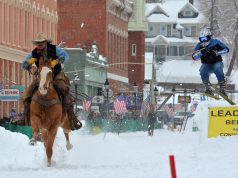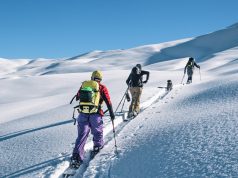
When it comes to exploration, humans are obsessed with being first — just look at the past century: Robert Peary planted the American flag at the North Pole in 1909 after scores of others died trying; Roald Amundsen became the first person to reach the South Pole in 1911 (Robert Scott, who was racing Amundsen, starved to death after discovering Amundsen had beaten him to the pole by 33 days); Edmund Hilary raced Charles Evans and Tom Bourdillon to the peak of Mount Everest in 1953 (both Evans and Bourdillon turned back); Yuri Gagarin orbited the Earth in 1961, essentially strapped into a tin can mounted on a three-stage rocket; the team of Apollo 11 faced unimaginable risks to land on the moon in 1969.
We will do anything — risk everything — to be first.
Boulder resident and polar adventurer Eric Larsen has had his share of firsts. He was the first person to complete expeditions to the North Pole, South Pole and Mount Everest in a 365-day period. He was also part of a team that accomplished the first summer expedition to the North Pole. In 2012, Larsen attempted to be the first person to reach the South Pole by bike, but dangerous conditions forced him to turn around after 175 miles. (Daniel P. Burton became the first person to bike to the southernmost point on Earth in 2014.)
But for Larsen’s most recent journey to the North Pole in the spring of 2014 (his third trip there), the focus was quite different.
“What does it mean to be last?” Larsen asks. “We are so hyper-focused on this idea of being first, but then what does it mean when these iconic adventures cease to exist?”
The Wisconsin native is seated at his desk at SMAK, the public relations and marketing company he runs with his wife Maria in Boulder. It’s just a few hours before the sneak preview of a two-hour, Animal Planet-produced documentary about Larsen’s latest trek to the North Pole with mountaineer Ryan Waters.
Melting: Last Race to the Pole uses footage captured by Larsen and Waters as they make the 480-mile journey from Canada’s northern Ellesmere Island to the geographic North Pole. Pulling all of their rations and gear behind them in 320-pound sleds, the explorers witness global warming first hand as the Arctic Ocean melts beneath their skis, leaving vast expanses of thinning ice and open water to traverse.
For Larsen, whose life’s work is built around trekking to the coldest regions of Earth, telling the story of the rapidly melting polar ice cap has been a top priority since his last expedition to the North Pole in 2006.
“That’s the funny thing about the Arctic Ocean — nobody knows about that adventure. Yet Everest… hundreds of people climb that every year. What happens when no one can?” he asks. “There would be a maelstrom of media around that.”
But Larsen knows the Arctic doesn’t elicit the same passion as the peak of a mountain or the edge of a canyon. There’s no summit to reach, no awe inspiring landscape as a reward for all the hard work. The Arctic is a frozen sea situated at the apex of the little blue dot we call Earth. It is, as Larsen puts it, “big, vast nothingness.”
And yet the polar ice cap, in all its nothingness, is perhaps the single most important moderator of world climate. As the Arctic Ocean and surrounding ice-covered areas like Greenland warm, more fresh water enters the ocean, changing the salt content.
Even small variations in salinity can have dramatic effects on ocean currents, which in turn have dramatic effects on weather conditions, temperature extremes, global climate patterns, gas cycling and nutrient systems that support marine life.
Ice sheets in general, no matter their location, are critical to the stability of Earth’s climate. The physical presence of ice reflects heat back into space, a process known scientifically as albedo.
“In any environmental condition, when you pull on one thing, there are a lot of other things that happen down the line,” Larsen says. “If the ice is gone, our climate is messed up big time.”
If the ice is gone, so are the playgrounds where Larsen has made his career as an adventurer. As such, he calls his desire to save these icy tundras “selfish,” but it’s clear that Larsen’s life is devoted to creating deeper connections between people and the environment, and being a professional adventurer was just a logical way to keep telling “compelling stories for as long as possible.”
Larsen studied biology and environmental studies, then spent time teaching, but he watched students come and go and wondered how to create a connection between the subject matter and the real world. A job as a dog musher in the Canadian Arctic eventually gave Larsen the opportunity to design a curriculum to go along with his sledding expeditions. Larsen says the expeditions gave him an “easy platform” to talk about larger issues, like global warming, while people were actually out in the world experiencing it.
“That said,” Larsen says with a grin, “I love the adventure stuff. I love the gear and equipment, just like any other nerd.”
And just like any true adventurer, Larsen couldn’t help but submit to the desire to push himself; in addition to filming their trek, Larsen and Waters also attempted to break the speed record for a full, unsupported Arctic expedition from Ellesmere Island to the pole. They would have to complete the trip in 51 days.
Filming added an extra burden to an already grueling journey, and Larsen admits — and the documentary shows — that the two explorers argued about filming. Waters had frostbite on both outer thighs, and food began to run dangerously low, forcing the two to cut many rations in half toward the end of the journey.
But they continued to film, and what they capture is an environment that is quickly fading. Ice that was once easily skiable at any time of day was often too thin during the afternoon. Difficult-to-cross pressure ridges (created by colliding pans of ice) were more numerous.
“For the average person looking, it’s hard to distinguish because the Arctic has looked like that throughout history — there’s open water, there’s cracks, there’s pressure ridges,” Larsen says. “What we saw more this year was fractured and broken up ice. To me, on a more qualitative first-hand experience, that is a symptom of thinner ice that’s not as strong. It breaks up more frequently, it becomes rougher.”
Larsen says they also noticed ice drift was greater and more affected by winds, carrying them southeast and away from the pole.
All of this adds up to the end of the exploration season coming earlier and earlier. Larsen and Waters had to reach the pole by May 4, as that was the latest date the support and logistics company would land a helicopter to pick them up. Larsen says he thinks this may signal the end of full expeditions like the one he and Waters took.
“I don’t foresee any other possible way of getting up there because the window is shrinking,” he says. “There’s a Russian company that creates a temporary ice base about 60 miles from the North Pole. Tourists can go and ski the last degree [of latitude] to the North Pole. That window of operations, they used to go through the beginning of May in 2010, then it was April 26, and now it’s April 21. The writing is on the wall for these adventures. Right now, another full expedition to the North Pole is highly unlikely. These shorter trips will keep happening for a while but I don’t know how much longer.”
And while Larsen may call his desire to save these frozen places selfish, he says adventurers like him have a responsibility to protect the places in which they play. His reasoning leads one to question: Do we all not have a responsibility to protect the Earth on which we live?
Larsen’s simple answer is yes.
“It’s easy to talk about these things, but we have to remind ourselves that we need to start moving. On our North Pole trip, there’s always stress. You’re making decisions, and no mater what we decide, it’s always crappy,” he says. “With climate, we don’t know if this will work or that will work, but at some point we just gotta go. We gotta start moving forward. We need to remind ourselves that there can be another solution that comes up from these first steps, but if we don’t take the first steps nothing will happen.”














